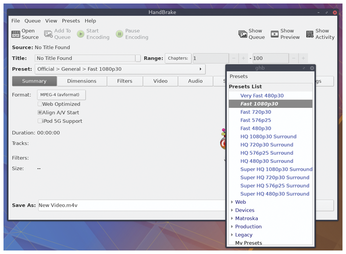FOSSPicks
HandBrake 1.1.0
It took 13 years to get to the 1.0 release, so it looks like the HandBrake team are putting some serious effort into keeping up the pace of development. And while the world seems to continue spinning when the majority of its denizens care little for media transcoding, if you have any interest in running your own media center, it's still an essential skill. The performance of low-powered devices, such as a Raspberry Pi, connected to your entertainment center and screen isn't so much limited by CPU power or hardware acceleration as it is by the demands set by the media you're trying to play. Even the humblest of ARM devices can play back 4K video if the codec is finely tuned, and good compression can make the difference between your WiFi reaching capacity and still being able to host two Netflix sessions alongside your Blade Runner binge.
This major update adds 4K preset support for lots of devices, including 2160p/4K for Apple TV, Chromecast, Fire TV, and Roku, with an additional preset for the Matroska Multimedia Container. There's also experimental Linux support for Intel Quick Sync Video, which is Intel's encoding and decoding acceleration. The user interface has also had a much needed tweak, now with floating presets and a workflow that goes from top to bottom and left to right, rather than the random array of clicks you needed to make in previous versions. If you'd rather use the command line, that gets some updates too, with support for adaptive streaming and JSON formatting for output scan and status information. It's because of updates like these that HandBrake has become the de facto tool for many who need to deal with media transcoding, and this is another major release.
Project Website

Python packager
pip 10
This is something I've not covered before in these pages, but it's something typically used every month to install a variety of dependencies that many of the things upon which we look depend. Pip is a Python package manager – or more accurately, the Python package manager. That a programming language like Python needs its own package manager says a lot about both Python's popularity and the way that many Python applications use modules and libraries from other packages. Pip is the way to handle all these distribution issues in a cross-platform and Python-friendly way, whether you're using Ubuntu or a Raspberry Pi. It should mean that installation is as simple as typing pip install qutebrowser.
Pip 10 is a big release, and it deals with one specific issue we've all known has been coming for years: Python 3 coexisting with Python 2.6. Python 3 has already been around for a long time, but because it does things so differently from the way previous versions of Python worked, it's meant that Python 2.x era tools, libraries, and applications have often remained current and even preferable. There's still Python 2.7, but deprecating 2.6 is a big step forward. This isn't really going to affect your use of Python, as you'll still be able to keep the same tools from the old era, and many installations have defaulted to calling pip either pip2 or pip3, depending on the overall dependencies, so you can still use pip2. The new version now includes a config command for creating, editing, adding to, and removing from a configuration, and the default upgrade strategy has become "only-if-needed," which will help people who want to stick to older versions of the software on which they rely.
Project Website

Buy this article as PDF
(incl. VAT)
Buy Linux Magazine
Subscribe to our Linux Newsletters
Find Linux and Open Source Jobs
Subscribe to our ADMIN Newsletters
Support Our Work
Linux Magazine content is made possible with support from readers like you. Please consider contributing when you’ve found an article to be beneficial.

News
-
TUXEDO Computers Unveils Linux Laptop Featuring AMD Ryzen CPU
This latest release is the first laptop to include the new CPU from Ryzen and Linux preinstalled.
-
XZ Gets the All-Clear
The back door xz vulnerability has been officially reverted for Fedora 40 and versions 38 and 39 were never affected.
-
Canonical Collaborates with Qualcomm on New Venture
This new joint effort is geared toward bringing Ubuntu and Ubuntu Core to Qualcomm-powered devices.
-
Kodi 21.0 Open-Source Entertainment Hub Released
After a year of development, the award-winning Kodi cross-platform, media center software is now available with many new additions and improvements.
-
Linux Usage Increases in Two Key Areas
If market share is your thing, you'll be happy to know that Linux is on the rise in two areas that, if they keep climbing, could have serious meaning for Linux's future.
-
Vulnerability Discovered in xz Libraries
An urgent alert for Fedora 40 has been posted and users should pay attention.
-
Canonical Bumps LTS Support to 12 years
If you're worried that your Ubuntu LTS release won't be supported long enough to last, Canonical has a surprise for you in the form of 12 years of security coverage.
-
Fedora 40 Beta Released Soon
With the official release of Fedora 40 coming in April, it's almost time to download the beta and see what's new.
-
New Pentesting Distribution to Compete with Kali Linux
SnoopGod is now available for your testing needs
-
Juno Computers Launches Another Linux Laptop
If you're looking for a powerhouse laptop that runs Ubuntu, the Juno Computers Neptune 17 v6 should be on your radar.

